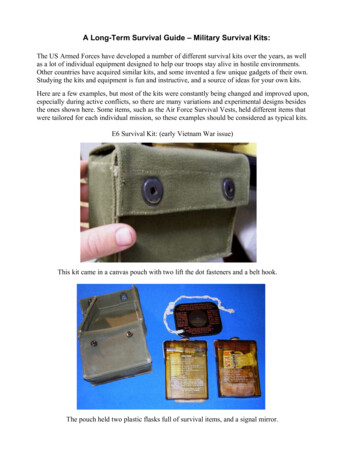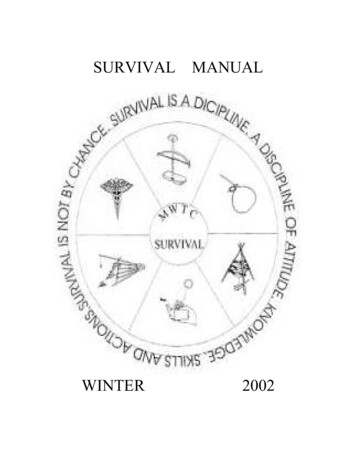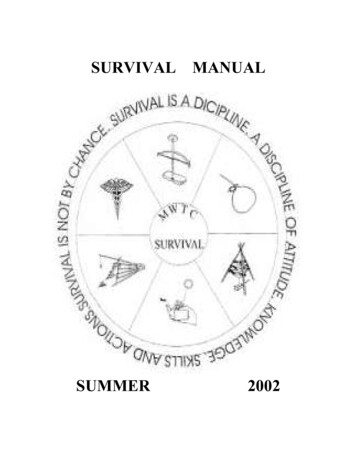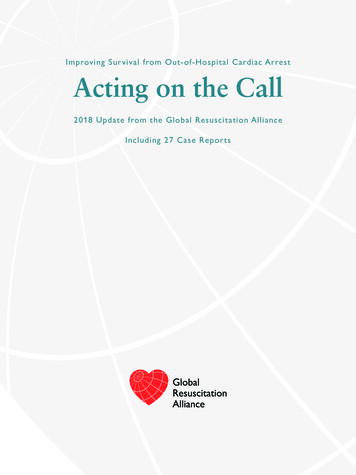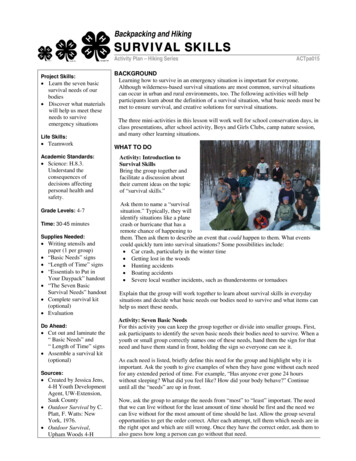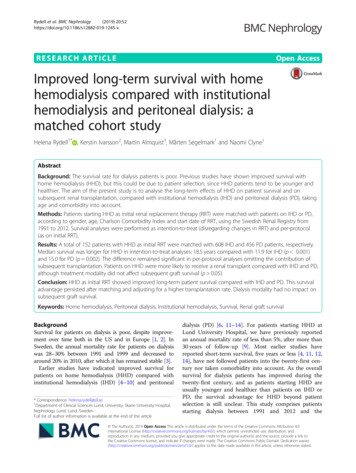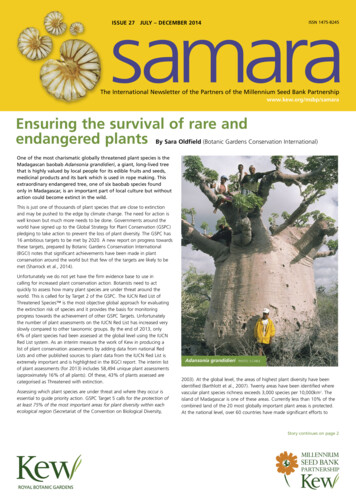
Transcription
samaraIssue 27 July – December 2014ISsN 1475-8245The International Newsletter of the Partners of the Millennium Seed Bank Partnershipwww.kew.org/msbp/samaraEnsuring the survival of rare andendangered plantsBy Sara Oldfield (Botanic Gardens Conservation International)One of the most charismatic globally threatened plant species is theMadagascan baobab Adansonia grandidieri, a giant, long-lived treethat is highly valued by local people for its edible fruits and seeds,medicinal products and its bark which is used in rope making. Thisextraordinary endangered tree, one of six baobab species foundonly in Madagascar, is an important part of local culture but withoutaction could become extinct in the wild.This is just one of thousands of plant species that are close to extinctionand may be pushed to the edge by climate change. The need for action iswell known but much more needs to be done. Governments around theworld have signed up to the Global Strategy for Plant Conservation (GSPC)pledging to take action to prevent the loss of plant diversity. The GSPC has16 ambitious targets to be met by 2020. A new report on progress towardsthese targets, prepared by Botanic Gardens Conservation International(BGCI) notes that significant achievements have been made in plantconservation around the world but that few of the targets are likely to bemet (Sharrock et al., 2014).Unfortunately we do not yet have the firm evidence base to use incalling for increased plant conservation action. Botanists need to actquickly to assess how many plant species are under threat around theworld. This is called for by Target 2 of the GSPC. The IUCN Red List ofThreatened Species is the most objective global approach for evaluatingthe extinction risk of species and it provides the basis for monitoringprogress towards the achievement of other GSPC Targets. Unfortunatelythe number of plant assessments on the IUCN Red List has increased veryslowly compared to other taxonomic groups. By the end of 2013, only6% of plant species had been assessed at the global level using the IUCNRed List system. As an interim measure the work of Kew in producing alist of plant conservation assessments by adding data from national RedLists and other published sources to plant data from the IUCN Red List isextremely important and is highlighted in the BGCI report. The interim listof plant assessments (for 2013) includes 58,494 unique plant assessments(approximately 16% of all plants). Of these, 43% of plants assessed arecategorised as Threatened with extinction.Assessing which plant species are under threat and where they occur isessential to guide priority action. GSPC Target 5 calls for the protection ofat least 75% of the most important areas for plant diversity within eachecological region (Secretariat of the Convention on Biological Diversity,Adansonia grandidieriPhoto: S.Cable2003). At the global level, the areas of highest plant diversity have beenidentified (Barthlott et al., 2007). Twenty areas have been identified wherevascular plant species richness exceeds 3,000 species per 10,000km2. Theisland of Madagascar is one of these areas. Currently less than 10% of thecombined land of the 20 most globally important plant areas is protected.At the national level, over 60 countries have made significant efforts toStory continues on page 2
Ensuring the survival of rare and endangered plantsContinued from page 1alternative. According to BGCI’s GardenSearch database(www.bgci.org/garden search.php), 275 botanicgardens in 66 countries now record having a seedbank. Of course, The Millennium Seed Bank Partnership(MSBP) coordinated by Kew, leads the way, workingin over 80 countries to conserve 25% of the world’sorthodox seed-bearing species. By August 2014, over35,000 verified taxa had been stored in the MSB. Ofthese, at least 4,666 are threatened taxa, according tothe various threatened species lists available. Efforts toassess the quality of these collections are ongoing.This year two exciting new projects have been launchedin a partnership between BGCI and the MSBP to boostprogress toward the GSPC targets. One is the GlobalSeed Conservation Challenge which will encourage morebotanic gardens around the world to establish local seedbanks to conserve plant species under threat. The other isthe Global Tree Seed Bank which specifically aims to boostthe number of globally threatened tree species that areconserved within the MSB by working with local partnersof the Global Trees Campaign (www.globaltrees.org).Once in a seed bank under conditions of low humidityand temperature, most seeds can survive for centuries.More importantly, material is available to researchersand conservationists for study and use. For example,collections held at the MSB and by its partners areavailable for restoration, and are frequently used for thispurpose (see previous issues of Samara).Adansonia grandidieriPhoto: S.Cableidentify important areas for plant diversity, but it is not yet clear how manyof these are being effectively managed or how well these are distributedacross ecological regions.Conservation of plants in their natural habitats is of vital importance inmaintaining the so-called ecosystem services that they provide and allowingevolutionary processes to continue. At the same time ex situ conservationof threatened plants in living collections and seed banks is an invaluableinsurance policy. GSPC Target 8 calls for ‘at least 75% of threatened plantspecies in ex situ collections, preferably in the country of origin, and at least20% available for recovery and restoration programmes’.A recent analysis has identified 29% of globally threatened species (asincluded on the IUCN 2013 Red List) in cultivation and/or seed banks.The endangered Adansonia grandidieri is currently recorded in 29 botanicgardens worldwide and, at the very least, plants in cultivation can be usedto highlight the plight of this species in the wild.While the focus of conservation work by botanic gardens traditionally hasbeen mainly through their living collections, there is increasing recognitionthat such collections do not include sufficient intra-specific genetic diversity.Where possible, seedbanking provides a desirable and cost-effectivesamara //2Progress towards the second part of GSPC Target 8(recovery and restoration) remains challenging. However,there is an increasing understanding of the importanceof linking in situ and ex situ conservation and usingcollections for restoration activities – both at species andecosystem levels. This is exemplified by the establishmentin 2012 of the Ecological Restoration Alliance of BotanicGardens in response to both Target 4 and 8 of theGSPC. Botanic gardens hold a huge amount of valuableknowledge for ecological restoration as well as plantmaterial for propagation and use in restoration schemes.Members of the Alliance have agreed to support effortsto scale up the restoration of damaged, degraded anddestroyed ecosystems around the world, with the goal ofrestoring 100 places by 2020.So is there hope for globally threatened plant species like Adansoniagrandidieri? The answer must be yes if we can compile the underlyingdata on threatened plants quickly and use it to prioritise local action withinternational support provided where necessary. Fortunately Adansoniagrandidieri is receiving specific attention through the Global Trees Campaignworking with local partner Madagasikara Voakajy and its future prospectsfor enhanced survival are looking good.ReferencesBarthlott, W., Hostert, A., Kier, G., Küper, W., Kreft, H., Mutke, J., Rafiqpoor, M.D. & Sommer, H.(2007) Geographic patterns of vascular plant diversity at continental to global scales. Erdkunde 61 (4)305-315.Sharrock, S., Oldfield, S. and Wilson, O. (2014) Plant Conservation Report 2014: a review ofprogress in implementation of the Global Strategy for Plant Conservation 2011–2020. Secretariatof the Convention on Biological Diversity, Montréal, Canada and Botanic Gardens ConservationInternational, Richmond, UK. (Technical Series No. 81, 56 pages.)Secretariat of the Convention on Biological Diversity [2003] Global strategy for plant conservation.Montreal, Secretariat of the Convention of Biological Diversity in association with Botanic GardensConservation n search.php
A message from Paul SmithAfter 18 years at Kew and nearly 15years at the Millennium Seed Bank, thiswill be my last contribution to Samara. Ileave with mixed feelings, of course, butmainly a feeling of great pride in whatthe Millennium Seed Bank Partnership hasachieved since its inception in 2000. By my estimate, we have bankedseeds from around 40,000 plant species, many of them rare andthreatened as illustrated so well in this edition of Samara.The future of these species, if not completely assured, is far brighter than itwas. We can store the vast majority safely for centuries; we know how togerminate most of them; and we are growing an increasing proportion ofthem in the landscape.Just as important as the seed collections themselves is the idea of seedconservation, an idea that has caught on globally. Large seed banks,designed specifically for wild species, have been built in Asia, Australasiaand Latin America in the past decade, and elsewhere the agriculture andforestry sectors are waking up to the importance of wild species as themeans to innovate and adapt.Although my career has taken me from microbiology to plant ecology toseed banking, I am a conservationist at heart and to me the challenge thatfaces all of us privileged enough to work in conservation is how better toconserve and manage species diversity for the benefit of future generations.Our working premise is that there is no technological reason why any plantspecies should become extinct, and I look forward to continuing to workwith you in the future to ensure that this hypothesis becomes a reality.A message fromColin ClubbeHead of the ConservationScience DepartmentAs Samara goes to press Kew is in the middle of a major review ofits science and science funding. In the face of declining governmentbudgets, a challenge we share with many institutions around theworld, we are looking at how we can secure the resources we needto continue our core science activities and maintain our hugelysuccessful global partnerships. We are developing a new sciencestrategy which we will launch in early 2015. The first phase of thescience restructure has established six new departments: Collections,Identification & Naming, Conservation, Natural Capital, ComparativePlant & Fungal Biology, and Biodiversity Informatics& Spatial Analysis.I have the great honour of being appointed as head of the ConservationScience Department and I am looking forward to working with theMillennium Seed Bank Partnership to continue to facilitate the manysuccessful conservation outcomes already achieved since 2000. Collectivelywe have the challenging target of banking 25% of the world’s bankableplant species by 2020. This target is important for the future of the world’splants and with all of your help we can achieve this target, improve theoutlook for plants globally and continue to provide plant-based solutions forsome of our greatest global challenges. I have worked in plant conservationfor most of my professional life and I have seen habitats and speciesCollecting seed of the endemic St Helena scrubwood(Commidendrum rugosum) Photo: V. Thomasdecline in the wild. I was part of an unsuccessful attempt to prevent onespecies going extinct. Had the Millennium Seed Bank Partnership been asactive then as it is now, I’m sure that the St Helena olive, Nesiota eliptica,would be more than just a herbarium specimen and an aliquot of DNA inKew’s collections. By focussing our collective efforts we can prevent speciesextinction and genetic erosion. The MSBP is central to achieving this.The search forHermas pillansii onTable MountainBy Sarah-Leigh Hutchinson, (SANBI – South AfricaNational Biodiversity Institute)Hermas pillansii* (Apiaceae) was one of the first plants to bediscovered from the Cape of Good Hope, South Africa, and wasillustrated in 1685 by Hendrik Claudius. Such an early discoverysuggests that this plant was a relatively common species or does it?Hermas pillansiiPhoto: S.-L. HutchinsonThe first published habitat description for Hermas pillansii indicates itspreference for growing on damp ledges of ‘scarcely approachable rocks’ onvertical cliff faces of the Cape Peninsula. Until very recently the last sightingand herbarium specimen collected was in 1938, not surprisingly perhaps,by that famously fearless mountaineer and botanist, T. P. Stokoe. After that,samara //3
The search for Hermas pillansii on Table MountainContinued from page 3Chris Browne scaling the cliffsPhoto: S.-L. Hutchinsonseven decades went by without a trace of this very special Table Mountainendemic, despite persistent searches by local botanists. Consequently,H.pillansii was feared extinct, due perhaps to disturbance from recreationalrock climbing across the mountain.In 2011, SANBI’s Red List scientist, Lize von Staden, posted a challenge onthe citizen science website, iSpot, asking any climbers and those ‘withoutfear of heights’ to try and help relocate this elusive plant. A year later, agroup of botanists led by Dr. Anthony Magee (Apiaceae expert at ComptonHerbarium) found a total of six plants of H. pillansii on the shaded, westfacing kloof, Fountain Ledge. A few months later, Chris Browne, of the localbotanical group CREW (Custodians of Rare and Endangered Wildflowers)found another H. pillansii plant, but this time in a locality last recorded in1928. Despite only finding one plant, Mr Browne was certain he could spota few more individuals on the cliffs below. All that was needed to prove hisassumption was some artful rock climbing and a touch of bravery. News ofthese fortuitous rediscoveries reached our MSB team at Kirstenbosch andarrangements were made to collect seed of this species which was, in allrespects of the word, living on the edge.It was a perfect summer morning in February as we set out for the cablecar station at the foot of that great South African icon, Table Mountain,the ‘mountain in the sea’ or ‘Hoerikwaggo’ as its earliest inhabitants theKhoi’san first named it. Accompanying our seed collecting team were MrBrowne and three CREW members. We were grateful for the extra pairsof eyes and especially Mr Browne’s firsthand knowledge of the mountainpaths. To maximise our search time, we decided to take the cable car to thesummit, albeit not without feeling we had cheated somewhat! Little did werealise, however, what a good decision this would turn out to be At the top was a breathtaking sight. We were the same height as a massiveexpanse of clouds resting on the horizon. We took a moment to drink inthe view and then followed Mr Browne’s lead across that magnificent ‘tabletop’. Before long we had found his site and the small H.pillansii perchedat the edge of the plateau. We carefully collected the mature seeds,samara //4Escaping the mistPhoto: S.-L. Hutchinsonsnapped some photographs, and braced ourselves for the real hunt thatlay steeply below us. After an adrenaline-filled hour of careful manoeuvresalong the cliffs, peeking into all the shaded crevices and overhangs, wewere extremely chuffed to return to the top, all limbs intact, and to addten more plants to the global population list! Strangely enough, all tenplants we had found were without flowering stems, just a handful ofbasal leaves, and thus we were unable to make more seed collections. Wepuzzled this over a quick lunch and then debated whether to call it a day ortackle a different cliff section. The cloud bank we had admired earlier wasnow resting on the city and every now and then a wispy cloud fragmentrushed past. Unperturbed, we decided to risk it. This time, heights gotdizzier and some of our team members stayed behind. Making our wayalong a very overgrown, forgotten contour, the rest of us came across agorgeously robust H.pillansii dripping with seed. Suddenly we noticed thecliff above us was punctuated with H.pillansii, all of them in seed and infull sun! Overjoyed, we gathered the seed which could be safely reachedand counted as many as thirty individuals. The answer to our lunchtimequestion seemed evident – H.pillansii must prefer the sunny, north-facingcliffs, as all our previous ten plants had been hidden in the shadows. Justthen we realised the mist and clouds were almost upon us. Making haste,we reached the top but the thick white tablecloth was already firmly inplace and within seconds our hair and eyelashes were dripping with waterdroplets and visibility was minimal. Thankfully, Mr Browne knew the way,and we hurried on in single file, hoping not to miss the last cable car.Looking like exhausted, drowned rats we must have made for a humoroussight that afternoon crammed together with all the tourists inside thelast cable car, but we didn’t mind, for our hearts were full from the day’sadventure, and the success of helping to conserve and solve the mystery ofthe no-longer elusive Hermas pillansii.*A new taxonomic revision of the genus Hermas by Dr. Anthony Magee is currently in press and as aresult the name Hermas pillansii will soon change to Hermas lanata.For further information contact Sarah-Leigh Hutchinson(S.Hutchinson@sanbi.org.za)
A seed conservation network for islandsof the Mediterranean BasinBy Sarah Hanson (Mediterranean Projects Support Officer, MSBP)Participants on a joint field trip to CyprusSeeds of Astragalus siculus, an endemic plantof Sicily, have been collected for the projectPhoto: A.KyratzisThe Mediterranean Basin is a biodiversity hotspot with nearly 25,000plant species – one in ten of all known plants, of which over halfare endemic to the region. It is however amongst the four mostsignificantly altered biodiversity hotspots on Earth with less than5% of its total land area protected in nature reserves. This meansthat, as well as being vulnerable to changes in climate, the majorityof plant species are unprotected from changes in land use causedby activities like tourism and agriculture. Nowhere is this threat feltmore than on islands where high levels of biodiversity and endemicrichness are combined with a wide range of habitats within a smallbut restricted area, reducing the opportunities for species migrationwhen conditions change.The ‘Ensuring the survival of endangered plants in the Mediterranean’project, funded by the MAVA Foundation, is an initiative led by sevenconservation organisations from Sicily, Sardinia, Cyprus, Corsica, Crete,Mallorca and the UK working together to protect the endangered floraof the six islands through ex situ seed conservation. The first phase of theproject ran for three years between October 2011 and September 2014 andhas seen many successes: Seeds have been collected from mainly endemic, rare, threatened orprotected taxa, stored in local seed bank facilities on the six islandsand backed up at the MSB. This has resulted in the protection ofover 900 endangered plant taxa. Germination tests continue to be carried out to assess the viability ofthe seed material and to ensure regeneration is possible. Data fromthis research, including germination protocols, is available to aid inconservation and restoration activities. The project has enabled a network of seed conservationists in theMediterranean Basin to be developed. This has improved localconservation initiatives, built relationships and facilitated resourcesharing between institutions and staff working in seed conservationacross the Mediterranean linking, for example, seed banks withuniversities and other research facilities. A programme of joint seed collecting trips has forged relationships aswell as improved local knowledge about the ecology and taxonomyof the flora of all six Mediterranean islands.Photo: G. P. Giusso The project has included higher-level training with MSc and PhD supportas well as a number of publications. Research projects include:An ecophysiological study of germination and dormancy in eightnative plant species from Crete.Taxonomical investigations on the endemic species of theSicilian flora.Molecular characterisation of secondary dormancy in theannual Silene integripetala subsp. greuteri. Seed dormancy andgermination niches of Mediterranean species along an altitudinalgradient in Sardinia.There have been three PhD summer schools, organised by theSardinian partner.The project has also been widely publicised and helped toincrease public awareness of the value and vulnerability of thelocal flora.There have been a few unexpected pleasant surprises along the way,including the discovery in a gorge in Crete of a population of Hypericumaegypticum subsp. webbii, previously thought to be extinct, and thediscovery of populations of Bellium artrutxensis in Mallorca and Ibiza,previously only recorded in Minorca.The first phase of this vital project has been a success on a number of levelsand should pave the way for future plant conservation activities in thisfragile region.Project partners: Royal Botanic Gardens, Kew, UK Jardí Botànic de Sóller, Mallorca Mediterranean Agronomic Institute Chania, Crete Conservatoire Botanique National de la Corse, Corsica The Agricultural Research Institute , Nicosia, Cyprus Centro Conservazione Biodiversità, University of Cagliari, Sardinia Dipartimento di Scienze Biologiche, Geologiche e Ambientali,University of Catania, SicilyFor further information contact Sarah Hanson (s.hanson@kew.org)Web: www.medislandplant.eusamara //5
The KMCC Orchid Conservation Project –working to conserve Madagascar’s mostendangered orchidsLandy Rajaovelona (KMCC Orchid Conservation Officer)Landy Rajaovelona inspectingyoung plants in the KewConservation Biotechnology UnitAngraecum longicalcar,Critically EndangeredPhoto: S.CablePhoto: S.CableThe Orchidaceae family in Madagascar is represented by over 1000species (8% of the flora) and 90% of these are endemic. Since 2012,the Kew Madagascar Conservation Centre (KMCC) has workedwith the Millennium Seed Bank (MSB) and the Kew ConservationBiotechnology Unit (CBU) to conserve the endangered orchids ofMadagascar. The seed collections are duplicated at the MSB andthe Silo National des Graines Forestières in Madagascar. Seeds arealso provided to Kew’s CBU for research on cryopreservation andpropagation to facilitate the reintroduction of the most criticallyendangered species. Our current focus is on conservation of the seedsof epiphytic species (standard storage at -20 C) and on conservationof the protocorms (embryonic seedlings) of terrestrial species throughcryopreservation (at -196 C) with their associated ectomycorrhizalfungi. We also aim to build conservation living collections of the mostthreatened species.In 2012, a joint expedition with Kew’s CBU made collections of seedsof the threatened species Angraecum longicalcar, A. protensum andA. magdalenae as well many other orchid species from the new ItremoMassif Protected Area in the Central Highlands, managed by Kew. In June2013, we returned to develop an in-vitro methodology, collecting maturefruit capsules and root fragments of 19 species of orchids belonging tothe genera Angraecum, Bulbophyllum, Cynorkis, Eulophia, Jumellea andPolystachya. In-vitro collecting allowed us to keep the fruit capsules intact ina nutrient gel with the seeds maturing inside. The root fragments allowedus to collect and isolate the ectomycorrhizal fungi and to test the feasibilityof storing seeds and fungi together.Propagation was greatly accelerated when seeds of Angraecum protensumand A. coutrixii were germinated with their associated fungi. Ten plants ofthe critically endangered A. protensum resulting from the experiments werereintroduced into the wild at the Itremo Massif to strengthen its population.samara //6Angraecum protensum, Critically EndangeredPhoto: S.CableThree sites have been visited for the MSBP recently: the Itremo Massif,the humid forest corridor of Fandriana-Marolambo and Antanifotsy nearAntananarivo. These trips have yielded seeds of 30 species belonging to thegenera Angraecum, Aerangis, Bulbophyllum, Cynorkis, Eulophia, Habenaria,Jumellea, Liparis, Microcoelia, Oeonia and Polystachya. Identification of orchidsis a difficult task when they are sterile, so we have planted living plants in theshade house at KMCC for subsequent identification when they flower.Preliminary IUCN Red-List assessments of 700 out of the 1000 known orchidspecies have been carried out so far. These use the full IUCN criteria, buthave not been submitted yet as we hope to refine them further with morefield surveys of populations. The analysis was based on more than 6,000herbarium records from the herbaria of the National Museum of NaturalHistory in Paris, the Tsimbazaza Botanical and Zoological Park in Madagascarand the British Museum and Royal Botanic Gardens Kew in the UK. Wefound that 72% of Madagascar’s orchids are threatened with extinctionand only 22% are of least concern. The extinction categories are: CriticallyEndangered 26%, Endangered 37%, Vulnerable 9%, Near Threatened 6%and Least Concern 22%. Less than 1% were classified as Data Deficient, butmany species have not been observed in the wild for many years or are onlyknown from a few records and have very small distributions (often singlepatches of forest).Targeting species for conservation is increasingly important as not all speciesare adequately covered by the protected area system. Orchids are a highprofile plant group in Madagascar and it is the largest plant family. Many arethreatened by illegal collecting and habitat loss from agriculture and charcoalproduction. We are developing a pipeline for conservation: systematicpreliminary IUCN conservation assessments, prioritisation of species, full IUCNassessments of priority species, conservation action plans, seed banking,cryopreservation and rescue projects for critically endangered species.For further information contact Stuart Cable (s.cable@kew.org)
Successfulgermination in rareor threatened speciesBy Alice Di Sacco (Germination Specialist, MSBP)and Sharon Balding (Information Project DevelopmentManager, MSBP)Cistanthe amarantoides,endemic to Chile Photo: M.Rosas, INIAEnsuring that collections stored at the MSB can be successfullygerminated is an important step in the management of thecollections. Rare and threatened species are the focus of particularattention regarding their germination requirements. If collections failthe initial germination tests, research is carried out into the taxonomyand ecology of the species and the habitat and climate of the areaof collection. Using this information, germination treatments canthen be more closely matched to the natural conditions. Literaturesearches are also carried out to check for successful germinationprotocols. In addition, seed dormancy mechanisms are considered andspecific treatments are applied.Here are a few examples of priority collections for which successfulgermination conditions have been found after a few failed s lichtensteiniana,endemic to St HelenaPhoto: T.HellerDistribution and Collection LocationEndemic to USA (North Carolina,Tennessee, Virginia); collected fromNorth Carolina3Abies fraseri (Pursh) Poir. PINACEAEEndangeredAustrobryonia argillicolaCUCURBITACEAEI.TelfordListed asVulnerable inEndemic to Northern Territory andNorthern Territory Queensland, Australia; collected inand Endangered in Northern Territory5QueenslandBulbostylislichtensteiniana (Kunth)C.B.ClarkeCYPERACEAEChironia jasminoides L.GENTIANACEAECistanthe amarantoidesPORTULACACEAE(Phil.) Carolin ex Hershk.Eucalyptus mitchellianaMYRTACEAECambageOchagavia litoralis(Phil.) Zizka, Trumpler & BROMELIACEAEZöllnerPhylica oleaefolia Vent.RHAMNACEAEEndemic to St. Helena9Least ConcernRareEndemic to Victoria, Australia9Vulnerable10Endemic to Chile; collected inValparaiso9Least ConcernPhylica rigidifolia Sond.RHAMNACEAELeast ConcernPinus cubensis Griseb.PINACEAELeast ConcernProtea witzenbergianaE.PhillipsPROTEACEAELeast ConcernSolanum pyracanthosLam.SOLANACEAESolanum remyanum Phil. SOLANACEAEEndemic to the Cape, South Africa;collected in Western Cape4,6Endemic to Chile; collected fromAntofagasta2Ochagavia litoralis, endemicto Chile Photo: M.Rosas, INIAConditionsGermination;Viability (%)Cold stratification at 0 C; 56 days. Then67; 6720 C; 56 days. Agar 1%Scarification (seed coat partiallyremoved to expose radicle) with scalpel.90; 90Then 30/15 C (Thermo-photoperiod8/16); 48 days. Agar 1%20 C; 168 days. Agar 1% with77; 85Gibberellic Acid (GA3) solution 250mg/l20/10 C (Thermo-photoperiod 8/16); 9788; 88days. Agar 1%Pierce seed coat in centre with a needle.94; 96Then 20 C; 56 days. Agar 1%Cold stratification at 0 C; 84 days. Then62; 6615 C; 77 days. Agar 1%15 C; 77 days. Agar 1%90; 90Endemic to the Cape, South Africa;Collected from Northern Cape4,615 C; 63 days. Agar 1%100; 100Endemic to the Cape, South Africa;collected in Western Cape4,615 C; 14 days. Then scarification (seedcoat partially removed) with scalpel.Then 15 C; 49 days. Agar 1%100; 10020 C; 35 days. Agar 1%41; 59Endemic to Cuba; Collected inGuantanamo3Endemic to Western Cape, SouthAfrica6,725/10 C (Thermo-photoperiod 8/16); 8467; 67days. Agar 1%Endemic to South East Madagascar;collected from Tuléar Province830/15 C (Thermo-photoperiod 12/12);63 days. Agar 1%86; 100Endemic to Chile; collected fromAntofagasta130/15 C (Thermo-photoperiod 12/12);70 days. Agar 1%86; 86Notes:The germination result is calculated as the percentage of germinated seeds out of full seeds sown.The viability result is calculated as percentage of germinated plus fresh seeds at cut test, out of fullseeds sown. Empty and insect infested seeds are excluded from the calculations.5. Nano, C., Kerrigan, & R. Albrecht, D. (2012) Threatened
samara //3 The search for Hermas pillansii on Table mountain Hermas pillansii* (Apiaceae) was one of the first plants to be discovered from the Cape of Good Hope, South




